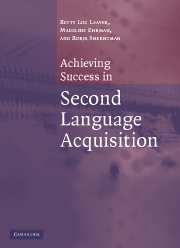Book contents
- Frontmatter
- Contents
- Notes on authors
- Acknowledgments
- Note to the reader
- Part I Learning
- Part II Language
- Part III Independence
- Epilogue: from here to there: attaining near-native proficiency
- Appendix A Answers to “practicing what you have learned”
- Appendix B Learning strategies taxonomies
- References
- Index
Appendix A - Answers to “practicing what you have learned”
Published online by Cambridge University Press: 12 November 2009
- Frontmatter
- Contents
- Notes on authors
- Acknowledgments
- Note to the reader
- Part I Learning
- Part II Language
- Part III Independence
- Epilogue: from here to there: attaining near-native proficiency
- Appendix A Answers to “practicing what you have learned”
- Appendix B Learning strategies taxonomies
- References
- Index
Summary
Most of the exercises you have encountered in this book have open answers; that is, there are many possible answers, quite a few of them highly personalized. The answer below is to the exercise that does have one right answer.
Answer to chapter 6, exercise 5
Steps to the solution:
To figure out what he needs to say, John will need to do a little more sleuthing, but he has almost everything he needs right now, thanks to these sentences that look like boring examples. (Any collection of examples, whether from a textbook or from authentic materials, can be used in a case like this for analysis.). So, here is what John can now do to be able to create the sentence that he needs.:
He can start his sentence with wawo.
From (3), it is clear that word order in Puyon is SOV. Second, he knows that the word for “homework,” once he figures it out, will have to come second and have an -u ending because all the direct objects in the sentences he has seen, e.g. in (3), have the -u ending.
“At home” will be craipinpon since pon is being used as a postposition (i.e. follows the noun instead of preceding), according to the sample sentences, and the location will be the third element in the sentence since the verb in all the sample sentences is at the end of the sentence.
The verb will be either tropirtropir or afpirpir; John does not have enough information yet to know which; however, he might be able to figure out that he will have to double the stem for the past tense and will need no ending on the verb because he is male.[…]
- Type
- Chapter
- Information
- Achieving Success in Second Language Acquisition , pp. 244 - 245Publisher: Cambridge University PressPrint publication year: 2005



